
(a)
Interpretation:
The mechanism and major product for the given Diels-Alder reaction is to be drawn.
Concept introduction:
The Diels–Alder reaction joins a conjugated diene and a dienophile (either an
Answer to Problem 24.44P
The mechanism and major product for the given Diels-Alder reaction is:

The
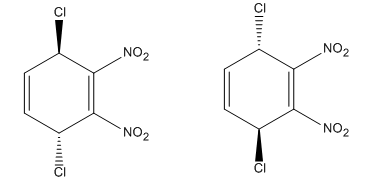
Explanation of Solution
The given reaction is:
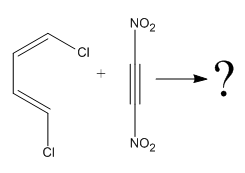
Here the diene is in trans configuration. For a Diels–Alder reaction to take place, the diene must be able to attain the

Each end carbon in the diene becomes a chiral center, noted with an asterisk. The

The mechanism and major product for the given Diels-Alder reaction is drawn from the structures of given reactants with stereochemistry.
(b)
Interpretation:
The mechanism and major product for the given Diels-Alder reaction is to be drawn.
Concept introduction:
The Diels–Alder reaction joins a conjugated diene and a dienophile (either an alkene or an alkyne) via the formation of two new
Answer to Problem 24.44P
The mechanism and major product for the given Diels-Alder reaction is:

The

Explanation of Solution
The given reaction is:
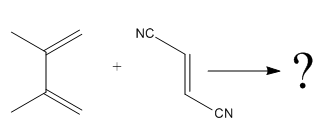
Here the cycloaddition, Diels-Alder reaction forms the six-membered ring product as:

In the above reaction, two carbons in the dienophile become chiral centers, noted with an asterisk.
The

The mechanism and major product for the given Diels-Alder reaction is drawn from the structures of given reactants with stereochemistry.
(c)
Interpretation:
The mechanism and major product for the given Diels-Alder reaction is to be drawn.
Concept introduction:
The Diels–Alder reaction joins a conjugated diene and a dienophile (either an alkene or an alkyne) via the formation of two new
Answer to Problem 24.44P
The mechanism and major product for the given Diels-Alder reaction is:

The
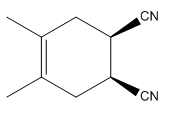
Explanation of Solution
The given reaction is:
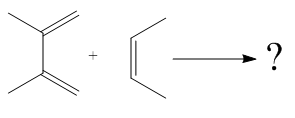
Here the cycloaddition, Diels-Alder reaction forms the six-membered ring product as:

The

The mechanism and major product for the given Diels-Alder reaction is drawn from the structures of given reactants with stereochemistry.
(d)
Interpretation:
The mechanism and major product for the given Diels-Alder reaction is to be drawn.
Concept introduction:
The Diels–Alder reaction joins a conjugated diene and a dienophile (either an alkene or an alkyne) via the formation of two new
Diels–Alder reactions tend to favor an endo product over an exo product
Answer to Problem 24.44P
The mechanism and major product for the given Diels-Alder reaction is:

Diels–Alder reactions tend to favor an endo product over an exo product:
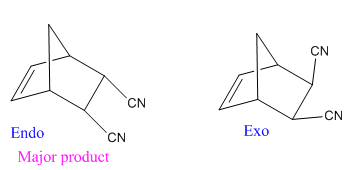
Explanation of Solution
The given reaction is:
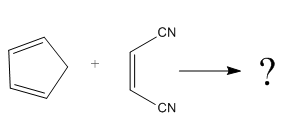
Here the cycloaddition, Diels-Alder reaction forms the bicyclic compound as product:

Here, it is noticed that two carbons of the diene and two carbons of the dienophile become chiral centers, noted with an asterisk.
The

The mechanism and major product for the given Diels-Alder reaction is drawn from the structures of given reactants with stereochemistry.
Want to see more full solutions like this?
Chapter 24 Solutions
EBK GET READY FOR ORGANIC CHEMISTRY
- Steps and explanations pleasearrow_forwardUse diagram to answer the following: 1.Is the overall rxn endo- or exothermic. Explain briefly your answer____________________2. How many steps in this mechanism?_____________3. Which is the rate determining step? Explain briefly your answer____________________4. Identify (circle and label) the reactants,the products and intermediate (Is a Cation, Anion, or a Radical?) Please explain and provide full understanding.arrow_forwardDraw the entire mechanism and add Curved Arrows to show clearly how electrons areredistributed in the process. Please explain and provide steps clearly.arrow_forward
- Match the denticity to the ligand. Water monodentate ✓ C₂O2 bidentate H₂NCH₂NHCH2NH2 bidentate x EDTA hexadentate Question 12 Partially correct Mark 2 out of 2 Flag question Provide the required information for the coordination compound shown below: Na NC-Ag-CN] Number of ligands: 20 Coordination number: 2✔ Geometry: linear Oxidation state of transition metal ion: +3 x in 12 correct out of 2 question Provide the required information for the coordination compound shown below. Na NC-Ag-CN] Number of ligands: 20 Coordination number: 2 Geometry: linear 0 Oxidation state of transition metal ion: +3Xarrow_forwardCan you explain step by step behind what the synthetic strategy would be?arrow_forwardPlease explain step by step in detail the reasoning behind this problem/approach/and answer. thank you!arrow_forward
- 2. Predict the product(s) that forms and explain why it forms. Assume that any necessary catalytic acid is present. .OH HO H₂N OHarrow_forwardconsider the rate of the reaction below to be r. Whats the rate after each reaction? Br + NaCN CN + NaBr a. Double the concentration of alkyl bromide b. Halve the concentration of the electrophile & triple concentration of cyanide c. Halve the concentration of alkyl chloridearrow_forwardPredict the organic reactant that is involved in the reaction below, and draw the skeletal ("line") structures of the missing organic reactant. Please include all steps & drawings & explanations.arrow_forward
 ChemistryChemistryISBN:9781305957404Author:Steven S. Zumdahl, Susan A. Zumdahl, Donald J. DeCostePublisher:Cengage Learning
ChemistryChemistryISBN:9781305957404Author:Steven S. Zumdahl, Susan A. Zumdahl, Donald J. DeCostePublisher:Cengage Learning ChemistryChemistryISBN:9781259911156Author:Raymond Chang Dr., Jason Overby ProfessorPublisher:McGraw-Hill Education
ChemistryChemistryISBN:9781259911156Author:Raymond Chang Dr., Jason Overby ProfessorPublisher:McGraw-Hill Education Principles of Instrumental AnalysisChemistryISBN:9781305577213Author:Douglas A. Skoog, F. James Holler, Stanley R. CrouchPublisher:Cengage Learning
Principles of Instrumental AnalysisChemistryISBN:9781305577213Author:Douglas A. Skoog, F. James Holler, Stanley R. CrouchPublisher:Cengage Learning Organic ChemistryChemistryISBN:9780078021558Author:Janice Gorzynski Smith Dr.Publisher:McGraw-Hill Education
Organic ChemistryChemistryISBN:9780078021558Author:Janice Gorzynski Smith Dr.Publisher:McGraw-Hill Education Chemistry: Principles and ReactionsChemistryISBN:9781305079373Author:William L. Masterton, Cecile N. HurleyPublisher:Cengage Learning
Chemistry: Principles and ReactionsChemistryISBN:9781305079373Author:William L. Masterton, Cecile N. HurleyPublisher:Cengage Learning Elementary Principles of Chemical Processes, Bind...ChemistryISBN:9781118431221Author:Richard M. Felder, Ronald W. Rousseau, Lisa G. BullardPublisher:WILEY
Elementary Principles of Chemical Processes, Bind...ChemistryISBN:9781118431221Author:Richard M. Felder, Ronald W. Rousseau, Lisa G. BullardPublisher:WILEY





